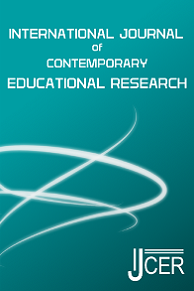The Effects of STEM PBL on Students’ Mathematical and Scientific Vocabulary Knowledge
Keywords:
STEM PBL, Mathematics and Science vocabularyAbstract
Vocabulary is at the surface level of language usage; thus, students need to develop mathematical and scientific vocabulary to be able to explicitly communicate their mathematical and scientific reasoning with others. The National Council of Teachers of Mathematics (NCTM) and the National Science Teachers Association (NSTA) have both created communication standards within mathematics and science disciplines. In the present study, science, technology, engineering, and mathematics (STEM) project based learning (PBL) methods were utilized during a summer camp in 2013 to encourage interest in and grow the knowledge of students in the STEM disciplines. The participants (N = 53; 18 female, 35 male, 5 Asian, 6 African American, 12 White, and 30 Hispanic) were 8th grade students. The paired-sample t tests’ results showed that the model of STEM PBL instruction elicited a statistically significant (p < 0.05) improvement in the mathematical and scientific vocabulary knowledge of students with the Cohen’s d effect size of 0.62 and 0.84 respectively. STEM PBL could be a beneficial instructional method concerning vocabulary mastery for students in science and mathematics classes.
References
Ashlock, B. R. (2005). Error patterns in computation: Using error patterns to improve instruction. Upper Saddle River, NJ: Prentice Hall.
Bay-Williams, J. M., & Livers, S. (2009, November). Supporting math vocabulary acquisition. Teaching ChildrenMathematics, 16(4), 238-245.
Bell, S. (2010). Project-based learning for the 21st century: Skills for the future. The Clearing House, 83, 39-43.
Bicer, A., Capraro, R. M., & Capraro, M. M. (2013). Integrating writing into mathematics classrooms to increase students’ problem solving skills. International Online Journal of Educational Science, 5(2), 361-369.
Bicer, A., Navruz, B., Capraro, R. M., Capraro, M.M., Oner, T.A., & Boedeker, P. (2015). STEM schools vs. non-STEM schools: Comparing students' mathematics growth rate on high-stakes test performance.
International Journal of New Trends in Education and Their Implications, 6(1), 138-150.
Bicer, A., Navruz, B., Capraro, R. M., & Capraro, M. M. (2014). STEM schools vs. non-STEM schools: Comparing students’ mathematics state based test performance. International Journal of Global Education, 3(3), 8-18.
Bicer, A., Capraro, R. M., & Capraro, M. M. (2014). Integrating writing into mathematics classroom as one communication factor. The Online Journal of New Horizon in Education, 4(2), 58-67.
Carrier, S. J. (2011). Effective strategies for teaching science vocabulary. Retrieved from
http://www.learnnc.org/lp/pages/7079
Cohen, M. T., & Johnson, H. L. (2011). Improving the acquisition of novel vocabulary through the use of imagery interventions. Early Childhood Education Journal, 38, 357-366.
Cohen, M. T. (2012). The importance of vocabulary for science learning. Kappa Delta Pi Record, 48(2), 72-77.
Cook, A. & Tulip, D (1992). The Importance of Selected Textbook Features to Science Teachers. Research in Science Education, 22, 91-100. Retrieved from http://link.springer.com/article/10.1007/BF02356883
Corlu, M. S., Capraro, R. M., & Capraro, M. M. (2014). Introducing STEM education: Implications for educating our teachers in the age of innovation. Education and Science, 39(171), 74-85.
Cirillo, M., Bruna, R. K., & Herbel-Eisenmann, B. (2010). Acquisition of mathematical language: Suggestions and activities for English language learners. Multicultural Perspectives, 12 (1), 34-41.
Faul, F., Erdfelder, E., Lang, A. G., & Buchner, A. (2007). G*Power 3: A flexible statistical power analysis for the social, behavioral, and biomedical sciences. Behavior Research Methods, 39, 175-191.
Fisher, D., Grant, M., & Frey, N. (2009). Science literacy is greater than strategies. Clearing House: A Journal of Educational Strategies, Issues and Ideas, 82(4), 183-86.
Groves, F.H. (1995). Science vocabulary load of selected secondary science textbooks. School Science and Mathematics, 95(5), 231-235.
Kenney, J. M., Hancewicz, E., Heuer, L., Metsisto, D., & Tutle, C. L. (2005). Literacy strategies for improving mathematics instruction. Alexandra, VA: Association for Supervision and Curriculum Development.
Monroe, E., & Orme, M. (2002). Developing mathematical vocabulary. Preventing School Failure, 46(3).
Miller, D. L. (1993). Making the connection with language. Arithmetic Teacher, 40(6), 311-316.
Miller, G. A., & Gildea, P. M. (1987). How children learn words. Scientific American, 257, 94-99.
National Council of Teachers of Mathematics. (1991). Professional standards for teaching mathematics. Reston, VA: Author.
National Council of Teachers of Mathematics. (1989). Curriculum and evaluation standards for school mathematics. Reston, VA: Author.
National Council of Teachers of Mathematics. (2003). Principles and standards for school mathematics. Reston, VA: Author.
National Science Teachers Association. (2014). Science and engineering practice. Retrieved from http://ngss.nsta.org/PracticesFull.aspx
Rubenstein, R. N. (2013). Focused strategies for middle-grades mathematics vocabulary development. Mathematics Teaching in the Middle School, 13(4), 200-207.
Steele, D.F. (1999). Research into practice: Learning mathematical language in the zone of proximal development. Teaching Children Mathematics, 6(1), 38-42.
Thomas, J. W. (2000). A review of research on project-based learning. Retrieved from http://www.newtechnetwork.org.590elmp01.blackmesh.com/sites/default/files/dr/pblresearch2.pdf
Thompson, D., & Rubenstein, R. N. (2000). Learning mathematics vocabulary: Potential pitfallsand instructional strategies. Mathematics Teacher, 93(7), 568-574.
Vacca, R. T., & Vacca, A. L. (1996). Content area reading (5th ed.). New York, NY: Harper Collins/College.
Yore, L.D., Craig, T. C., & Maguire, T.O. (1998). Index of science reading awareness: An interactiveconstructive model, test verification, and grades 4-8 results. Journal of Research in Science Teaching, 35(1), 27-51.
Downloads
Published
How to Cite
Issue
Section
License
Copyright (c) 2022 Ali Bicer, Peter Boedeker, Robert M. Capraro, Mary M. Capraro

This work is licensed under a Creative Commons Attribution-NonCommercial 4.0 International License.




